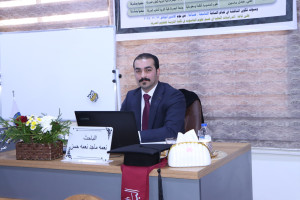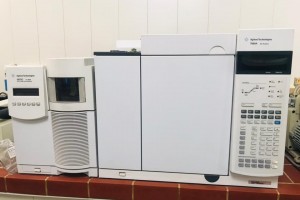
The College of Education for Pure Sciences in the Department of Chemistry at the University of Basra organized a scientific lecture on the preparation of complexes of azo dyes derived from diketones and the study of their analytical and medical applications
The lecture, which was moderated by the researcher (Noor Abdel Hakim Abdel Razzaq), included
The study included the preparation of seven new azo-beta-ketone compounds. The direct method was used to prepare azo compounds (N1-N5,N8,N9). The azo-beta-diketone compounds were prepared in two steps, the first of which included the preparation of diazonium salt (nitrification) of four amines:
[(Luminol)-(Procaainehydrochloride)-(Sulfamerazine)-(Sulfaguanidine)]
. The second step was a coupling process to obtain the required azo compounds, in which the diazonium solution was gradually added with continuous stirring alternately to the acetyl acetone and benzoyl acetone solution.
It was diagnosed using the micro-analysis technique (C.H.N), and it was also diagnosed using proton nuclear magnetic resonance (1H-NMR) and infrared technology (FT-IR), as well as the compounds were diagnosed by mass spectrometry. The visible rays spectra of the compounds prepared with different solvent group were studied.
The complexes were characterized using FT-IR, mass spectrometry, TG and C.H.N. As well as studying molar conductivity, magnetic sensitivity, and atomic-flame absorption with nickel and copper(II).
The medical applications of the ligands and their complexes were studied, their efficacy as antioxidants was measured and compared with vitamin C (ascorbic acid) as a positive control by DPPH assay, using a concentration of 1000 µg/ml, and using a UV.vis device. The results showed that the ligands N1, N2, N8 and N9 had good inhibitory values against S. aureus bacteria, where the inhibition radii reached (11, 14, 13, 12 mm) respectively, while the ligands N3, N4 and N5 No efficacy was shown against the bacteria themselves. As for the complexes (N1Cu, N2Cu, N4Cu, and N8Cu) they showed the activity of the direction of S. aureus bacteria, where the inhibition radii reached (11, 9, 11, 12, 10 mm), respectively.
lecture recommended
The ability of the prepared azo compounds as clinics to form complexes with copper(II) and(II) nickel, and the results of the health examinations of the proposed compounds proved.








